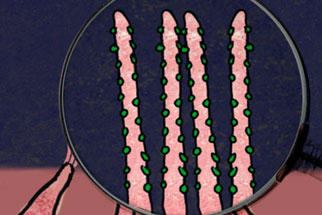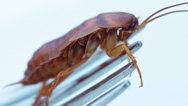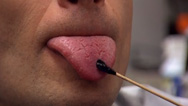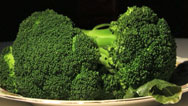Tour the Tongue
- By David Levin
- Posted 06.01.09
- NOVA scienceNOW
How does our sense of taste work, and why did it evolve? What are taste buds, and how do they register the five basic sensations of sweet, salty, bitter, sour, and umami (a Japanese word describing something "meaty")? In this audio interactive, Danielle Reed of the Monell Chemical Senses Center offers a primer on what happens on your tongue, and in your brain, as you eat.
 Launch Interactive
Launch Interactive
Learn how our sense of taste works, and why we evolved the ability to detect flavors like bitter and sweet.
Transcript
Tour of the Tongue
(SECTION 1)
NARRATOR: Danielle Reed is a researcher at the Monell Chemical Senses Center in Philadelphia. She studies the biochemistry of taste.
DANIELLE REED: If you think about it, things we taste are things that we absolutely have to make a decision about. So when you put something in you mouth that you're going to swallow, you need to sample it to make a decision about whether you're going to ingest it.
NARRATOR: But how do we actually do that?
DANIELLE REED: let's start with the whole tongue.
DR: If you stick out your whole tongue, looking in the mirror, the first thing you'll notice is that there are little pink bumps on your tongue. And those are called taste papillae.
NARRATOR: Papillae comes from the Latin word for nipple.
DANIELLE REED: Because that's a little bit what they look like. And in those papillae are many taste buds.
NARRATOR: And those, as the name implies, are what actually do the tasting. Most taste buds are on the sides, back, and tip of your tongue. And they're all basically the same. Every bud can sense a variety of tastes. That's because they're all made of a variety of specialized cells, and each cell can sense different chemicals.
There's one for sweet-tasting molecules, another one for bitter, and others for salty, sour, and Umami. That's the Japanese word for the savory taste in meat and cheese.
The bulk of these cells are buried in the flesh of the tongue. But the very top of each one pokes out onto the mouth. That's the business end of a taste cell. It has tiny finger-like structures on it called microvilli.
DANIELLE REED: And these little fingers are what actually sense the tastes that are in the mouth. So really the part of the taste bud that actually ever sees a taste is very, very small.
NARRATOR: These microvilli have hundreds of receptors on them. Those are tiny areas on the cell wall that can tell if specific chemicals are near them. So when you eat something sweet like a banana, the sugar molecules inside it touch a sugar receptor,
DANIELLE REED: and this sets off a signal from tongue to brainâ¦
NARRATOR: And our brain says, "hey, there's something sweet here!"
DANIELLE REED: And we call that thing a taste.
NARRATOR: But why did we evolve these five specific tastes in the first place?
(SECTION 2)
(SWEET)
DANIELLE REED: So the ability to taste sweet really starts when a sugar or another kind of sweet molecule touches the sweet receptor on the taste receptor cell. And that sets off a chain reaction that's perceived by the brain as sweet.
There's only one sweet receptor, but it's actually quite elaborate because it allows us to taste sweetness from molecules that have a whole different molecular structure—from just simple sugars to more unusual things like the high-intensity sweetener saccharine, or aspartame and so forth.
Being able to sense sugar is a very useful thing to do for animals that need carbohydrates for energy. Sugar is not only a good source of energy because it's very easy to absorb, and rapid, but it's also a very safe source of calories.
(UMAMI)
DANIELLE REED: Umami is a word that not a lot of people are familiar with, but it essentially translates in the Japanese language as "delicious taste". The umami receptor responds to things like monosodium glutamate and things which we would probably call savory.
The ability to perceive umami is actually quite important, because that is very commonly found in protein foods, meats and so forth. The amino acid glutamate, which is part of the umami taste sensation, is also found in some vegetables and fruits. For instance, tomatoes are very high in glutamate. And if you think about it, tomatoes really do have that wonderful sort of savory flavor. The other thing people often say is very umami-like is chicken broth. Because we taste the protein.
(BITTER)
DANIELLE REED: Although there's only one sweet receptor and one umami receptor, there's actually 25 different kinds of bitter receptors. And we think that there're so many bitter receptors because so many structurally diverse molecules in our environment are potentially toxic to us. So we really want to be able to sense all of these potentially toxic chemicals and avoid them.
But some things that are bitter are not necessarily bad for us in all circumstances. So one hypothesis is that we need to be really able to sense low concentrations of bitterness because when we're sick, we want to be able to sample all the different plants and find things that help us get better, but we don't want to eat too much of them.
So for instance chimpanzees actually self-medicate some of their parasite problems by eating bitter plants, but they only eat those bitter plants when they're sick or unwell. So bitterness is a two-way street—it allows us to detect things that are potentially toxic, and it allows us to have an exquisite sensitivity so we can take in a little bit of something bitter that might do us some good.
(SOUR)
DANIELLE REED: The way we taste sour is very different from the way that we taste bitter, umami, and sweet. In the case of bitter, umami, and sweet, the taste molecule touches the receptor but doesn't actually enter into the cell. But this is probably not true for the sense of sour. A sour molecule contacts the receptor, and there's actually an open channel so the sour molecule flows inside the cell, which sets off a cascade of events which signals to the brain that you've eaten something sour.
There are really two reasons we need to sense sour. One is that it's a protective factor like with bitter in that if we eat things that are very sour, too acidic, it can actually throw off our body chemistry and destroy cells in our gut. So we need sour perception to keep us away from things which will cause tissue damage. But we also like to sense sour because it helps us sort of meter out the ripeness of our food. So for instance if you have a choice between a sour apple and a sweet apple, from an evolutionary perspective you're better off eating the apple that's sweet and not sour.
When a piece of fruit tastes sour, it necessarily is less nutritious than it could be otherwise, because the natural carbohydrates in the fruit haven't turned into sugars yet.
(SALTY)
DANIELLE REED: So the way we sense salt is similar to the way we sense sour, with the idea that the receptor probably creates a hole and allows the sodium to flow into the taste receptor cell and set off a series of signals.
The reason we need to sense salt is it's absolutely essential to our biological function. Salts are very important in nerve conductance and in many other biological systems. But if you think about it, we don't save up salt in our body. There's no salt reservoir. We have reservoirs of fat and reservoirs of carbohydrate but there's' no salt supply in the body that we can draw on in times of need. So we have to be very clever in getting salt in our diet and we have to do that every day. And so that's one of the reasons that humans and other mammals are exquisitely aware of and seek out and are good at detecting salt.
Credits
Images
- (Danielle Reed)
- Courtesy Danielle Reed
- (banana)
- istockphoto/Baloncici
- (all others)
- © WGBH Educational Foundation
Related Links
-

Can I Eat That?
Learn about the neuroscience of taste, why we cook our food, what makes a Thanksgiving turkey savory, and more.
-

The Science of Picky Eaters
Don't like broccoli? Your DNA may explain why, because your sense of taste is largely encoded in your genes.
-

Neuroscience of Taste
Discover how "flavor magicians" perform tricks on our senses.
-

Blocking Bitter Taste
Neil deGrasse Tyson meets a genetically modified mouse that can't sense bitter tastes.
You need the Flash Player plug-in to view this content.



